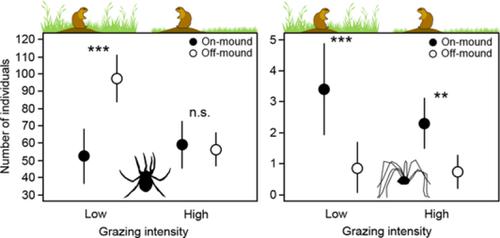当前位置:
X-MOL 学术
›
Insect Conserv. Divers.
›
论文详情
Our official English website, www.x-mol.net, welcomes your
feedback! (Note: you will need to create a separate account there.)
Spider (Araneae) and harvestman (Opiliones) communities are structured by the ecosystem engineering of burrowing mammals
Insect Conservation and Diversity ( IF 3.2 ) Pub Date : 2019-09-30 , DOI: 10.1111/icad.12382 Peter Lindtner 1 , Peter Gajdoš 2 , Slavomír Stašiov 1 , Marek Čiliak 3 , Pavel Pech 4 , Vladimír Kubovčík 1
中文翻译:

蜘蛛(Araneae)和收割者(Opiliones)社区是由挖洞哺乳动物的生态系统工程构建的
更新日期:2019-09-30
Insect Conservation and Diversity ( IF 3.2 ) Pub Date : 2019-09-30 , DOI: 10.1111/icad.12382 Peter Lindtner 1 , Peter Gajdoš 2 , Slavomír Stašiov 1 , Marek Čiliak 3 , Pavel Pech 4 , Vladimír Kubovčík 1
Affiliation

|
- Burrowing mammals through their digging activities are important ecosystem engineers and bioturbators in grassland ecosystems. Through habitat formation, they can have significant effects on other species in an ecosystem, structuring their abundance and diversity.
- We analysed the effect of the European ground squirrel (Spermophilus citellus) on spider (Araneae) and harvestman (Opiliones) communities, because these arachnids are the most abundant and dominant predators with a great variety of foraging strategies, and their community composition is strongly influenced by the physical structure of the environment.
- We established replicate mound plots positioned directly in the centre of ground squirrel mounds with paired off‐mound control plots undisturbed by ground squirrels. We sampled spiders and harvestmen using pitfall traps on 30 ground squirrel mounds and 30 paired off‐mound control plots at two study sites differing in grazing intensity and plant species richness.
- We found that the response of spiders was site‐specific, while harvestmen responded consistently to disturbances by burrowing mammals. Mounds exhibited increased abundance and species richness of harvestmen at both study sites, while species richness of spiders was increased only in intensively managed grassland. We also detected compositional changes of the arachnid community on the mounds in comparison to the grassland matrix.
- Our findings indicate that burrowing mammals through physical state changes in abiotic and biotic material modulate the resources for other species and maintain a high diversity of biotic communities in intensively grazed grasslands.
中文翻译:

蜘蛛(Araneae)和收割者(Opiliones)社区是由挖洞哺乳动物的生态系统工程构建的
- 通过挖掘活动挖掘哺乳动物是草原生态系统中重要的生态系统工程师和生物扰动者。通过栖息地的形成,它们可以对生态系统中的其他物种产生重大影响,从而构造其丰富度和多样性。
- 我们分析了欧洲地松鼠(Spermophilus citellus)对蜘蛛(Araneae)和Harvestman(Opiliones)社区的影响,因为这些蜘蛛是最丰富和占优势的掠食者,具有多种觅食策略,并且它们的群落组成受到强烈影响由环境的物理结构决定。
- 我们建立了直接位于地松鼠丘陵中心的复制丘陵图,并建立了不受地松鼠干扰的成对场外控制图。我们在两个研究地点的放牧强度和植物物种丰富度不同的30个地松鼠丘和30个成对的非丘陵控制地上使用陷阱陷阱对蜘蛛和收割者进行了采样。
- 我们发现蜘蛛的反应是针对特定地点的,而收割者则通过挖掘哺乳动物来一致地应对干扰。在两个研究地点,土堆都表现出收割者丰度和物种丰富度的增加,而蜘蛛的物种丰富度仅在集约化管理的草地上有所增加。我们还检测了与草地基质相比,丘陵上蜘蛛纲动物群落的组成变化。
- 我们的发现表明,通过非生物和生物材料的物理状态变化来挖洞哺乳动物可以调节其他物种的资源,并在高强度放牧的草地上维持高度的生物群落多样性。











































 京公网安备 11010802027423号
京公网安备 11010802027423号